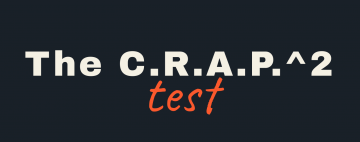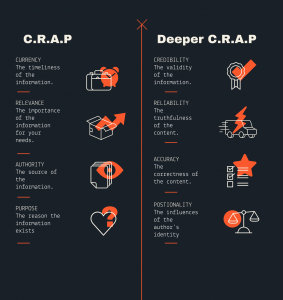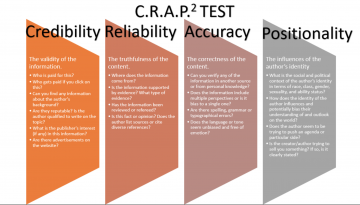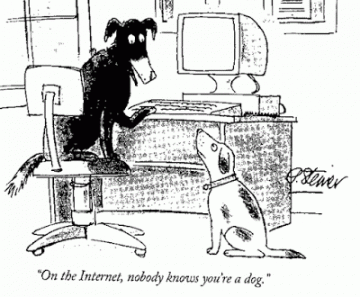In the age of information, the internet and digital technology have changed the boundaries of education and finding information online is now easier than ever. The internet is a great tool for student-led learning, but also a dangerous one. Before students can access the power of digital information, they need to understand how it can also mislead and manipulate their thinking. An increase in online accessibility has made the digital landscape far more complex and also easier to influence through the diffusion of false stories. Although access to digital resources remains an important equity issue, digital information has never been more popular, making digital literacy an essential subject in the school curriculum. With the rise of “Fake news” in our everyday lives, this week in the mentoring circle, we ask, how can we tell the difference between fact and fiction?
Practicing critical digital literacy means having the skills and abilities to critically navigate through the digital landscape by discerning online information. As we are bombarded with news and information feeds 24/7, how do we know what is true and what is false? The creation of fake news comes from the intent of spreading false and misleading information many times comes as clickbait to capture attention and profit from advertisements. When people fall for and start to share false information it creates a vicious cycle of misinformation that spreads. This is known as circular reporting, when information from just one source is made to look like it’s coming from multiple sources, making it seem valid. How do we avoid falling into circular reporting and contributing to the spread of “Fake News”? By Double-Checking Our Facts!
As the term “Fake News” has become everything from political agendas to conspiracy theories, the first step is to understand the difference between disinformation and misinformation. Disinformation is false information that is deliberately created and spread in order to manipulate, influence public opinion or even obscure the truth. While misinformation is false or inaccurate information that is mistakenly or inadvertently created or spread; the intent is not to deceive, it is a mistake. However, through misinformation, we can spread disinformation and contribute to circular reporting, that is why students need to think critically about online sources and evaluate where they get their information from. How can we motivate students to seek out fact-checks and ensure they have the digital literacy skills and abilities to evaluate information and find trustworthy answers?
Critical media literacy has always required a good eye for reliable sources and the willingness to dive deep into a source and determine what is true and what isn’t. But beware…the internet isn’t an open library; it’s a predetermined experience. Algorithms powering search engines and social media timelines often choose what we see, tailoring our browsing experience based on our search histories. Algorithms serve the purpose of showing us content or ads that closely align with our interests, but they can also push information our way. Media hacking increases the visibility of ideas, stories and or even movements. With the hope that circular reporting of false breaking news will lead to the continuous sharing of misinformation. The following video explains how spreading “Fake News” works and how the internet can stop it.
Multiple studies suggest that social media is the single largest gateway to “Fake News,” so how can we find and remove bias and lies from our news feeds? The C.R.A.P.2 test could help solve this question. The C.R.A.P.2 is a personal adaptation of the model first created by Molly Beestrum and Kenneth Orenic at Dominican University. It is a helpful tool to use when trying to decide if a website is a credible and valid source. The C.R.A.P.2 Test is a list of criteria to help you evaluate the information you find. Different criteria will be used more or less important depending on the information you encounter. Below find the criteria to get into deeper C.R.A.P.!




A great digital tool that can help you identify false information is Checkology. This renowned resource from the News Literacy Project is helping everyone to be more judicious and educated when it comes to understanding bias. The Checkology virtual classroom is a browser-based platform where middle school and high school students learn how to navigate today’s challenging information landscape by developing critical digital literacy skills. Through its lessons, educators equip their students with tools to evaluate and interpret information and to determine what they can trust, share and act on. In the following video, digital journalism teacher David Teeghman leads his students at Michele Clark Academic Prep Magnet High School in Chicago through the “Misinformation” lesson on Checkology.
Critical digital literacy is more than identifying misinformation and disinformation; it means being able to critically assess the news, call out false information and participate meaningfully in online communities to stop the spread. It becomes a civic act! Sometimes disinformation is posted deliberately to promote a political agenda. Bots, cyber-attacks and the spread of “Fake news” have completely altered elections around the world. Countries like Mexico, Brasil, U.S.A. & Canada have been profoundly affected socially, politically and economically through the spread of “Fake News” with the intention to manipulate voting citizens and obtain the power to destabilize democracy. In this shocking clip from The Great Hack, we hear about the Cambridge Analytica campaign that was devised and successfully deployed in Trinidad and Tobago to alter the youth vote and ultimately influence an election result.
Knowledge should never be seen as unproblematic. As some say, truth is perspective and it lies in the lens of the beholder. Could understanding multiple perspectives and knowing other people’s truths augment our lens? If knowledge is not a single truth to be acquired, how can we be critical about the process of finding what is true for each of us? How can we be critical of our thinking and engage in an inquiry against biased structures that maintain the status quo? It is essential to question where our knowledge comes from and who it benefits. We need to open a critical eye in our thinking and unveil multiple perspectives that question our current assumptions. As we teach in a world surrounded by “Fake News”, reflecting on what knowledge we carry is the only way to stop the spread of misinformation. In a digital world where information is at the tip of our fingers and anyone can have a voice, we have to be critical of the voice we choose to listen to.
